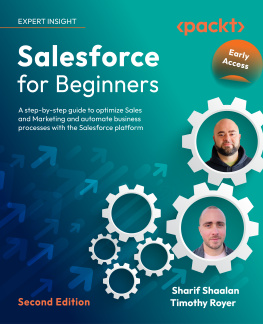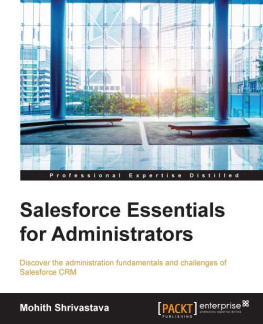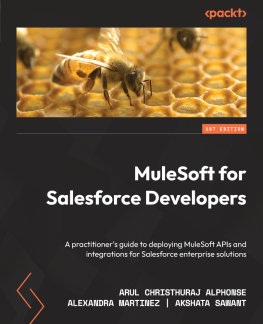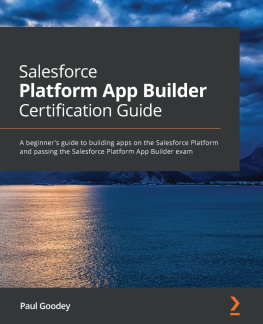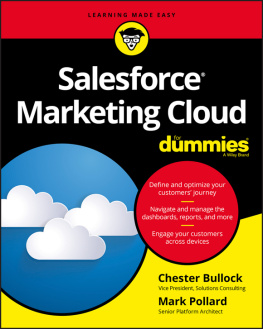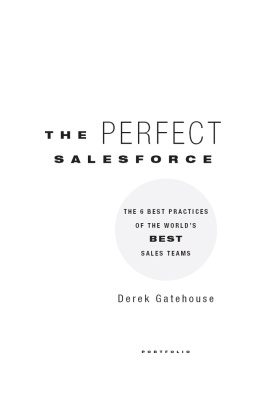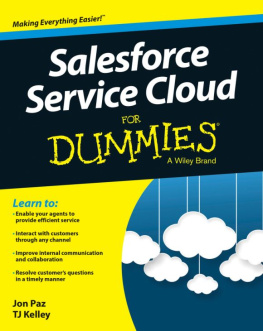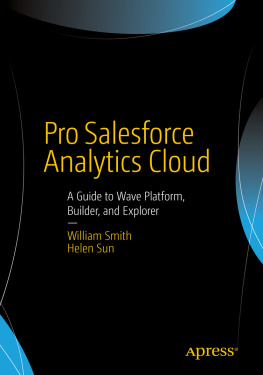Sharif Shaalan - Salesforce for Beginners
Here you can read online Sharif Shaalan - Salesforce for Beginners full text of the book (entire story) in english for free. Download pdf and epub, get meaning, cover and reviews about this ebook. year: 2022, publisher: Packt Publishing, genre: Home and family. Description of the work, (preface) as well as reviews are available. Best literature library LitArk.com created for fans of good reading and offers a wide selection of genres:
Romance novel
Science fiction
Adventure
Detective
Science
History
Home and family
Prose
Art
Politics
Computer
Non-fiction
Religion
Business
Children
Humor
Choose a favorite category and find really read worthwhile books. Enjoy immersion in the world of imagination, feel the emotions of the characters or learn something new for yourself, make an fascinating discovery.
- Book:Salesforce for Beginners
- Author:
- Publisher:Packt Publishing
- Genre:
- Year:2022
- Rating:4 / 5
- Favourites:Add to favourites
- Your mark:
- 80
- 1
- 2
- 3
- 4
- 5
Salesforce for Beginners: summary, description and annotation
We offer to read an annotation, description, summary or preface (depends on what the author of the book "Salesforce for Beginners" wrote himself). If you haven't found the necessary information about the book — write in the comments, we will try to find it.
Sharif Shaalan: author's other books
Who wrote Salesforce for Beginners? Find out the surname, the name of the author of the book and a list of all author's works by series.
Salesforce for Beginners — read online for free the complete book (whole text) full work
Below is the text of the book, divided by pages. System saving the place of the last page read, allows you to conveniently read the book "Salesforce for Beginners" online for free, without having to search again every time where you left off. Put a bookmark, and you can go to the page where you finished reading at any time.
Font size:
Interval:
Bookmark:

Copyright 2022 Packt Publishing
All rights reserved. No part of this book may be reproduced, stored in a retrieval system, or transmitted in any form or by any means, without the prior written permission of the publisher, except in the case of brief quotations embedded in critical articles or reviews.
Every effort has been made in the preparation of this book to ensure the accuracy of the information presented. However, the information contained in this book is sold without warranty, either express or implied. Neither the author, nor Packt Publishing, and its dealers and distributors will be held liable for any damages caused or alleged to be caused directly or indirectly by this book.
Packt Publishing has endeavored to provide trademark information about all of the companies and products mentioned in this book by the appropriate use of capitals. However, Packt Publishing cannot guarantee the accuracy of this information.
Early Access Publication: Salesforce for Beginners
Early Access Production Reference: B18426
Published by Packt Publishing Ltd.
Livery Place
35 Livery Street
Birmingham
B3 2PB, UK
ISBN: 978-1-80323-910-1
www.packt.comOnce upon a time, before Facebook and iPhones, businesses ran their operations using on-premises software. These operations included managing customers and their interactions with the sales, customer service, and marketing departments of the organization. On-premises meant that the servers that ran this software were within the physical infrastructure of the business. Having the servers onsite meant huge maintenance and upkeep costs, as well as long deployment times for the smallest of changes. In 1999, Marc Benioff and his co-founders started Salesforce.com. As Benioff states in his book, Behind the Cloud, the idea was to make software easier to purchase, simpler to use, and more democratic, without the complexities of installation, maintenance, and constant upgrades. Salesforce was at the forefront of Software as a Service (SaaS) and cloud computing.
Fast-forward to 2022, when Salesforce.com reported $21.25 billion in total revenue in FY 2021 and is now constantly expanding the platform and acquiring new companies. This led to the Salesforce economy, which Salesforce projects to have created 9.3 million jobs by 2026. How did Salesforce get to this point? It started as a Customer Relationship Management (CRM) tool; then, over the years, it morphed into a powerful business platform with various clouds, including Sales Cloud, Service Cloud, Marketing Cloud, Analytics Cloud, Experience Cloud, and many more.
In this book, we will focus on Sales Cloud and Service Cloud. These two clouds contain all of the core CRM functionality, which is the foundation of all the other clouds and sets up the path for you as the end user or aspiring admin to continue learning.
Salesforce is a platform to build your entire business on. Don't let the word sales mislead you. The platform supports the ability to manage all aspects of a business, including sales, customer service, marketing, finance, and much more, through out-of-the-box functionality and customization.
In this chapter, we will cover the following topics:
- Understanding the core concepts of CRM
- Understanding the difference between Salesforce Lightning and Salesforce Classic
- Learning how to navigate Salesforce
- Learning about the different search options
- Learning how to use list views across all objects
- Learning what Salesforce Chatter is and how to use it in your organization
- Learning the personal settings options available to end users
CRM includes all interactions with an organization's constituents. This includes prospecting, the sales process, retention, marketing efforts, and customer service. The core of Salesforce is the out-of-the-box CRM functionality that is provided when you sign up for the platform. There are various editions provided by Salesforce; each edition provides different features and per-user price points. The four editions of the core CRM product are as follows:
- Salesforce Essentials: A small-business CRM for up to 10 users
- Salesforce Professional: A complete CRM for any size of team
- Salesforce Enterprise: A deeply customizable sales CRM for your business
- Salesforce Unlimited: Unlimited CRM power and support
Salesforce uses the concept of different clouds to bring together specific features. For example, all of the core features of running a sales operation, such as lead and opportunity management, are included in Sales Cloud. Features such as cases and knowledge bases fall under Service Cloud. There are also other clouds, such as Marketing Cloud, Analytics Cloud, and so on. The preceding editions in the bullet list focus on Sales Cloud and/or Service Cloud.
There is also a developer edition. The developer edition is one of the most valuable training tools when starting to learn how to use Salesforce, especially if you don't have access to a Salesforce environment of your own to practice what you are learning. Developer edition orgs are free, full-featured enterprise orgs with less storage and a limit of two licenses. These orgs are made for you to try out and develop features in an environment that is not directly tied to a paid production org. You can sign up for unlimited developer orgs. Regardless of the edition, the core objects are the same; we will cover them in detail in the following chapters of this book.
In this book, we will use the terms environment, org, and instance interchangeably. These three words mean the same thingthe configuration that you see when you log in to a unique version of Salesforce. This can be a development org, a client's production org, or a sandbox. We will cover sandboxes in Chapter 12, Manage Projects Effectively Using Sandboxes and Change Sets.
Now is a good time to go to https://developer.salesforce.com/signup and sign up for your own developer edition.
As we walk you through the concepts of this book, you can follow along on your own org. As you sign up, you will be asked to enter a company name. If you don't belong to a company, don't worryjust re-enter your name for the company name since it is a required field.
Over the years, Salesforce has had a few UI makeovers to keep up with the latest trends in usability and design. The latest, and by far the biggest, UI change Salesforce has carried out is the introduction of Salesforce Lightning in 2015. This was a fundamental change to the look and feel that Salesforce users were used to and brought with it many new features that are only available on Lightning. Some of these features include the following:
- A modern UI
- The Lightning Component framework, which allows developers to build responsive applications for any device with less effort
Many organizations that have used Salesforce for a long time either plan to migrate, or have already migrated to Lightning. When Lightning was released, the older Salesforce UI was renamed to Salesforce Classic to differentiate between the two. The following screenshots show the exact same page in Salesforce Classic and Salesforce Lightning. Notice the option to toggle between the two interfaces. This means any user you grant this permission to can switch back and forth between Classic and Lightning. This feature helps with adoption when you first bring users on to Lightning.
Font size:
Interval:
Bookmark:
Similar books «Salesforce for Beginners»
Look at similar books to Salesforce for Beginners. We have selected literature similar in name and meaning in the hope of providing readers with more options to find new, interesting, not yet read works.
Discussion, reviews of the book Salesforce for Beginners and just readers' own opinions. Leave your comments, write what you think about the work, its meaning or the main characters. Specify what exactly you liked and what you didn't like, and why you think so.

